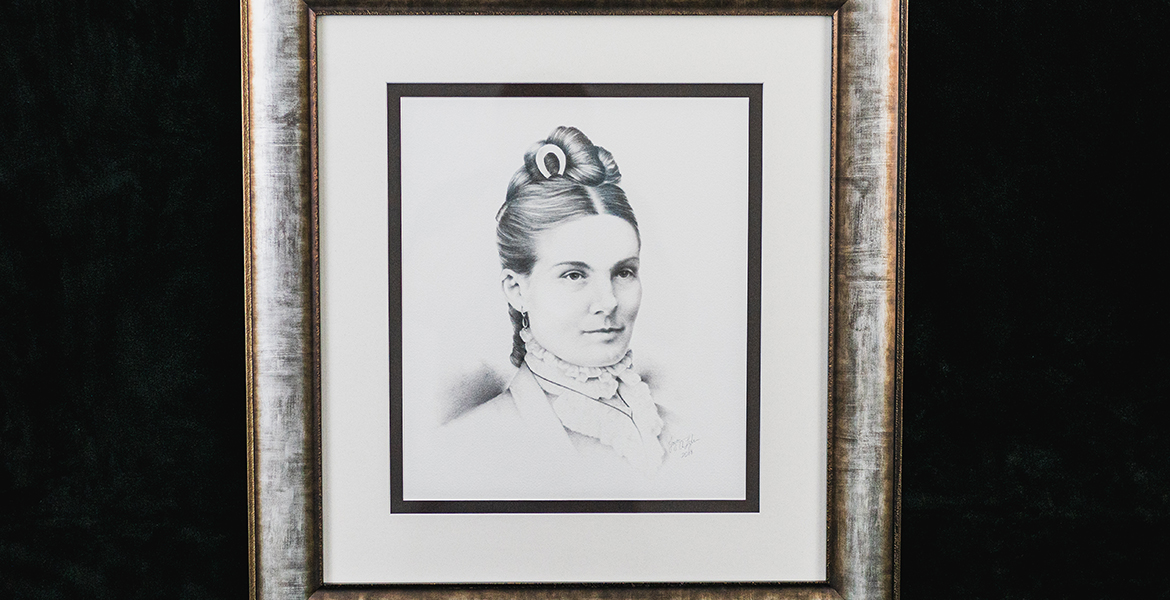
Focus on Native American Art: Joyce Lyle
Thursday, November 19, 2020
Joyce Lyle, Cherokee Nation citizen and resident of Tahlequah, has been an artist all her life, and millions of people hang her artwork in their homes every Christmas.
Lyle worked at Hallmark for more than 25 years primarily creating and designing 2D and 3D Christmas ornaments.
“I made a lot of angels, and I worked on a lot of the religious ornaments,” she said.
Now another one of her pieces, a charcoal portrait of a historical Cherokee woman, will hang permanently in the OSU College of Osteopathic Medicine at the Cherokee Nation.
The facility located in Tahlequah is the first tribally affiliated medical school site in the country. In addition to classrooms, clinical skills labs and a simulation center, the building will also house 125 pieces of Native American art.
The portrait is of Dr. Isabel Cobb, a Cherokee Nation citizen and first female physician in Indian Territory who Lyle has a very personal connection with.
“My great aunt was Isabel Cobb. She was my mom’s aunt,” she said. “Aunt Belle was my mom’s hero. Several years ago, I decided I wanted to draw my Aunt Belle. I knew my mom was close to her and even lived with her for awhile.”
Cobb attended the Cherokee National Female Seminary, now Northeastern State University, before attending medical school in Pennsylvania. She returned to Oklahoma in 1893 and worked as a frontier physician in what was then Indian Territory.
“She’s a very strong and stoic woman. I remember seeing photos of her in our family albums and she always seemed so strong,” Lyle said, so she tried to portray those qualities in the portrait she created. “Having that connection made it personal.”
Lyle works in a number of mediums in addition to charcoal including oil painting, pottery, watercolor, mosaics, clay sculpture and now she’s even learning bronze sculpture.
“I enjoy creating. I love beautiful things, I love flowing lines and beautiful colors,” she said.
"It’s great making something with your hands and it suddenly becomes what you had imagined in your head."
But Lyle said she may never have become an artist if it weren’t for her older brother Jerald Graham.
“I began drawing when I was in grade school, but he was the one who inspired me to be an artist. He was actually my art teacher at McLain High School in Tulsa,” she said.
Since her retirement from Hallmark in 2006, Lyle said she’s continued to work and learn in the art community in and around Tahlequah, including from Cherokee artists.
Gina Olaya, director of Cultural Art & Design for Cherokee Nation Businesses, formed a committee of people from OSU Center for Health Sciences to select pieces submitted from Cherokee Nation artists to be displayed in the new building.
“It is my goal the students, faculty and staff learn about our Cherokee history, culture and heritage through visual art,” Olaya said.
Dr. Natasha Bray, associate dean of Academic Affairs, and Ashlei Ashmore, director of operations at OSUCOM at the Cherokee Nation, were both on the art selection committee.
“We wanted the artwork inside the building to represent the community outside. Working with the talented Gina Olaya we put out a request for submissions for art related to health, family, and healing to Cherokee artists,” Bray said. “The scope of submissions took my breath away: the depth of the talent in so many different mediums, their willingness to share their work, and their vision of health and Cherokee culture.”
It was also very personal for Ashmore.
“As a Cherokee citizen I am proud to see the Cherokee art displayed throughout the facility. Each piece comes from skills and traditions that have been passed down through the generations,” she said.
"To see my tribe’s culture and rich history as I walk the halls makes this more than a building. It makes it a home."
Lyle said she was honored that her portrait of Dr. Isabel Cobb, a trailblazer for female Native American physicians, will now be displayed in the medical school near where she practiced medicine.
“Everyone who enters that building will see Aunt Belle. They’ll see so much beautiful Native art there,” she said. “Medical school can’t be an easy thing. Looking at beautiful art can inspire you. If you’re Cherokee and a student, seeing art by your Cherokee people would be inspiring.”
MEDIA CONTACT: Sara Plummer | Communications Coordinator | 918-561-1282 | sara.plummer@okstate.edu
